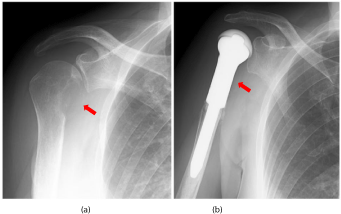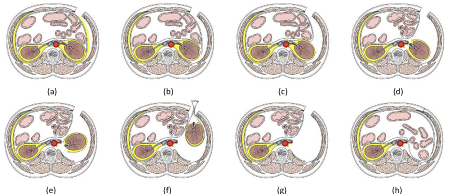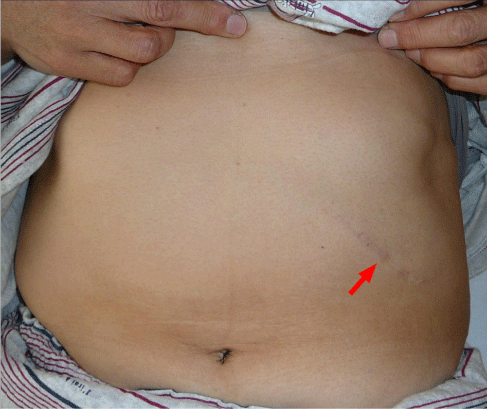
Special Article - Surgical Case Reports
Austin J Surg. 2015;2(1): 1047.
Successful Treatment of Renal Cell Carcinoma with Contralateral Humeral Metastasis by Gasless Laparoendoscopic Single-Port Radical Nephrectomy via Retroperitoneal Anterior Subcostal Incision
Fujisaki A, Komatsubara M, Kameda T, Morikawa A, Kubo T, Kurokawa S and Morita T*
Department of Urology, Jichi Medical University, Japan
*Corresponding author: Morita T, Department of Urology, Jichi Medical University, Shimotsuke-city, Tochigi 3290498, Japan
Received: October 27, 2014; Accepted: January 05, 2015; Published: January 07, 2015
Abstract
The positioning and type of incision are important initial steps for successful surgery without complications. We occasionally encounter the Renal Cell Carcinoma (RCC) patients who are suitable for supine positioning rather than flank positioning in Radical Nephrectomy (RN). Thus, we developed an approach via a small Retroperitoneal Anterior Subcostal Incision (RASI) in the supine position for RN by gasless laparoendoscopic single-port surgery (GasLESSRN) which is one of the minimally invasive surgeries. This is the first case report of RCC with contralateral humeral metastasis managed by GasLESSRN via RASI in the supine position and suggests that the approach via a small RASI is an alternative useful approach for GasLESSRN in RCC patients who are considered suitable for supine positioning.
Keywords: Retroperitoneal anterior subcostal incision; Radical nephrectomy; Renal cell carcinoma; Supine position; Gasless laparoendoscopic single-port surgery
Abbreviations
RASI: Retroperitoneal Anterior Subcostal Incision; GasLESS: Gasless Laparoendoscopic Single-port Surgery; GasLESSRN: Gasless Laparoendoscopic Single-port Radical Nephrectomy; RCC: Renal Cell Carcinoma; RN: Radical Nephrectomy; POD: Postoperative Day; TASI: Transperitoneal Anterior Subcostal Incision
Introduction
Radical Nephrectomy (RN) by gasless laparoendoscopic singleport surgery (GasLESS) (GasLESSRN ) developed by Kihara et al. [1] is one of the minimally invasive surgeries. Namely, GasLESSRN is performed retroperitoneal in the flank position via a small incision that just permits extraction of the resected specimen (4-6 cm in length) under magnified vision with an endoscope in combination with stereovision without CO2 or trocar ports or insertion of the hands into the operation field [2]. It was shown to be a safe, feasible, cost-effective minimally invasive treatment option for T1-3 RCC with oncologic outcomes equivalent to those of conventional open radical nephrectomy [3]. However, we occasionally encounter the RCC patients who are suitable for supine positioning rather than flank positioning in RN. For overcoming the problems due to the flank positioning in GasLESSRN, we developed an approach via a small Retroperitoneal Anterior Subcostal Incision (RASI) in the supine position for GasLESSRN and showed its safety and feasibility [4]. Herein, we present the first case report of GasLESSRN via RASI in the supine position in an RCC patient with contralateral humeral metastasis who is not suitable for flank positioning.
Case Report
A 54-year-old woman visited a nearby orthopedic clinic with a complaint of right shoulder pain. X-ray examination of the right shoulder showed osteolytic lesion in the right humerus (Figure 1(a)), suggesting metastatic bone tumor. Ultrasound examination revealed the space occupying lesion in the left kidney. She received 10 mg/day oxycodone for shoulder pain control and was referred to our institution for further examination and treatment. CT scan showed that osteolytic lesion in the right humerus (Figure 2(a)) and hypervascular tumor in the left kidney (5cm in diameter) (Figure 2(b)). Final clinical diagnosis was RCC with metastasis to the right humerus (cT1bN0M1). After discussion of the treatment strategy with the patient and her family, hemiarthroplasty for metastasis to the proximal humerus was undertaken for pain control and the prevention of the pathological bone fracture (Figure 1 (b)). Pathological examination showed clear cell carcinoma suggesting metastasis of RCC to the right humerus. Although Nephron-Sparing Surgery (NSS) which is currently the preferred option for T1 RCC might be the treatment of choice for the present case, left GasLESSRN via RASI in the supine position [4] was performed based on their request 2 months later. Briefly, under general anesthesia, she was placed in a supine position with back extension. A subcostal incision was made parallel to the tip of the rib from the lateral border of rectus abdominis muscle toward the flank without cutting rectus abdominis muscle in 6-cm length (Figure 3(a)). Only external oblique muscle was incised in the line of incision, and the internal oblique and transverse muscles were split. Wound retractor (Alexis Wound Protector/Retractor™, Applied Medical Resources Corp., USA) and surgical retractor (Gray Surgical Retractor System, Gray Surgical, Australia) were set and subsequent procedures were performed using long instruments under direct vision and video image with a flexible endoscope (Olympus Corp., Japan) without gas insufflation and without insertion of the hands in the operating field. Then, lateroconal fascia was exposed and incised by excising surrounding fatty tissue (i.e., flank pad) and Gerota`s fascia was exposed (Figure 3(b)). The peritoneum was retracted medially with blunt dissection to expose anterior surface of the kidney covered with Gerota`s fascia (Figure 3(c)). After dissection toward the renal hilum, renal artery and vein, and then left ureter were exposed, double ligated, and transected (Figure 3(d)). After freeing the remaining renal attachments (Figure 3(e)), the specimen was extracted through the RASI using a retrieval device (Kobamed Flexible Catcher™, Kobayashi Medical Co., Ltd., Japan) as shown in Figures 3(f) and 3(g). In the present case, the wound was extended to 8 cm to extract the specimen. All three muscle layers including transverse, internal oblique and external oblique muscles were approximated after placing a 16F drainage tube, and then the skin was closed intracutaneously (Figure 3(h)). The total operative time and estimated blood loss were 195 min. and 130 mL, respectively. There were no intra- and post-operative complications. A clear liquid diet and walking were started on postoperative day (POD) 1, and she was discharged to home on POD 4. Pathological examination showed clear cell carcinoma of the left kidney (pT1N0M1), which was compatible with the bone metastatic lesion. After the GasLESSRN, she did not have any additional pain without analgesics or additional functional deterioration of right shoulder. She is now well without any evidence of recurrence at 2 years and 8 months after GasLESSRN (Figure 4).

Figure 1: Shoulder X-rays (a) before and (b) after hemiarthroplasty for
metastasis to the proximal humerus (arrow).

Figure 2: CT scan showing (a) osteolytic lesion in the right humerus (arrow)
and (b) hypervascular tumor in the lower pole of the left kidney (arrow).

Figure 3: Schematic illustration of the procedures of RASI-GasLESSRN. A subcostal incision was made parallel to the tip of the rib from the lateral border of rectus
abdominis muscle toward the flank (a) and then lateroconal fascia was exposed and incised by excising surrounding fatty tissue (yellow part) (b). The peritoneum
was retracted medially(c), and renal artery and vein were double ligated and transected (d). After freeing the remaining renal attachments (e), the specimen was
extracted through the RASI using a retrieval device (f) (g). All three muscle layers and the skin were closed (h).

Figure 4: Wound (arrow) of RASI at 2 years and 8 months after GasLESSRN.
Discussion
In the present RCC patient with contralateral humeral metastasis, right flank position for left GasLESSRN was not appropriate because compression of the shoulder should be avoided after contralateral shoulder joint plasty. Thus, we employed the approach via a small RASI in the supine position for GasLESSRN [4] and successfully performed it without intra- and post-operative complications, especially in terms of right shoulder joint pain and function. Present case suggests that GasLESSRN via a small RASI in the supine position is beneficial to RCC patients with skeletal diseases or deformities such as contralateral shoulder joint diseases, nonunion of the clavicle, and scoliosis [5]. Other advantages of this approach via RASI in the supine position include the followings; (1) there is no delay due to the positional change from the supine to flank position ;(2) it also avoids the potential risks associated with flank positioning, including peripheral nerve injuries such as brachial plexus neuropraxia [6], rhabdomyolysis [7], unilateral pulmonary edema (i.e., down lung syndrome) [8], and atelectasis in the dependent lung [9] ; (3) it provides better visualization of the renal hilus, adrenal gland, and anterior surface of the kidney [10], and a familiar anatomical view of the kidney, especially for surgeons familiar with conventional RN via a Transperitoneal Anterior Subcostal Incision (TASI) in the supine position [11] ; (4) it is easy to convert the approach into the conventional TASI with the incision of the peritoneum if required. The approach via a small RASI has some disadvantages as follows. First, it is time consuming to retract the peritoneum medially and expose the anterior side of the kidney covered with Gerota`s fascia because the site of the lateral peritoneum reflection is located anterior to the posterior axillary line. Second, the subcostal incision might result in the unsightly scar formation in the upper quadrant of the abdomen since it is not along Langer`s lines.
Conclusion
Present case suggests that the approach via a small RASI is an alternative useful approach for GasLESSRN in RCC patients who are considered suitable for supine positioning.
Acknowledgement
The authors declare that there is no conflict of interests regarding the publication of this case report.
Authorís Contributions
AF, MK, TK, and AM performed data collection, and AF and TM drafted the manuscript. AF, TM, TK, and SK performed the operations. All authors have read and approved the final manuscript.
References
- Kihara K, Kageyama Y, Yano M, Kobayashi T, Kawakami S, Fujii Y, et al. Portless endoscopic radical nephrectomy via a single minimum incision in 80 patients. Int J Urol. 2004; 11: 714-720.
- Kihara K. Application of gasless laparoendoscopic single port surgery, GasLESS, to partial nephrectomy for renal cell carcinoma: GasLESS-clampless partial nephrectomy as a multiply satisfactory method. Int J Urol. 2012; 19: 3-4.
- Iimura Y, Kihara K, Saito K, Masuda H, Kobayashi T, Kawakami S. Oncological outcome of minimum incision endoscopic radical nephrectomy for pathologically organ confined renal cell carcinoma. Int J Urol. 2008; 15: 44-47.
- Morita T, Fujisaki A, Kubo T, Kurokawa S. Approach via a small retroperitoneal anterior subcostal incision in the supine position for gasless laparoendoscopic single-port radical nephrectomy: initial experience of 42 patients. BMC Urol. 2014; 14: 29-33.
- Novick AC, Stephen JS, Gill IS, Klein A, Rackley R, Ross JH. Surgical Incisions. Operative Urology at the Cleveland Clinic, Totowa, NJ, Human Press Inc. 2006; 1-16.
- Shenoya S, Wardb P, Wigmorec T. Surgical management of urological malignancy: Anaesthetic and critical care considerations. Current Anaesthesia & Critical Care. 2009; 20: 22−27.
- Reisiger KE, Landman J, Kibel A, Clayman RV. Laparoscopic renal surgery and the risk of rhabdomyolysis: diagnosis and treatment. Urology. 2005; 66: 29-35.
- Snoy FJ, Woodside JR. Unilateral pulmonary edema (down lung syndrome) following urological operation. J Urol. 1984; 132: 776-777.
- Klingstedt C, Hedenstierna G, Lundquist H, Strandberg A, Tokics L, Brismar B. The influence of body position and differential ventilation on lung dimensions and atelectasis formation in anaesthetized man. Acta Anaesthesiol Scand. 1990; 34: 315-322.
- Baptista-Silva JC, Poli de Figueiredo LF, Camara AL, Demuner MS, Castro MJ, Verissimo M, et al. Outcome of 605 consecutive living donor nephrectomies through an anterior subcostal retroperitoneal approach. Transplant Proc. 2002; 34: 451-452.
- Mejean A, Vogt B, Quazza JE, Chretien Y, Dufour B. Mortality and morbidity after nephrectomy for renal cell carcinoma using a transperitoneal anterior subcostal incision. Eur Urol. 1999; 36: 298-302.
Citation: Fujisaki A, Komatsubara M, Kameda T, Morikawa A, Kubo T, Kurokawa S and Morita T. Successful Treatment of Renal Cell Carcinoma with Contralateral Humeral Metastasis by Gasless Laparoendoscopic Single- Port Radical Nephrectomy via Retroperitoneal Anterior Subcostal Incision. Austin J Surg. 2015;2(1): 1047. ISSN: 2381-9030.